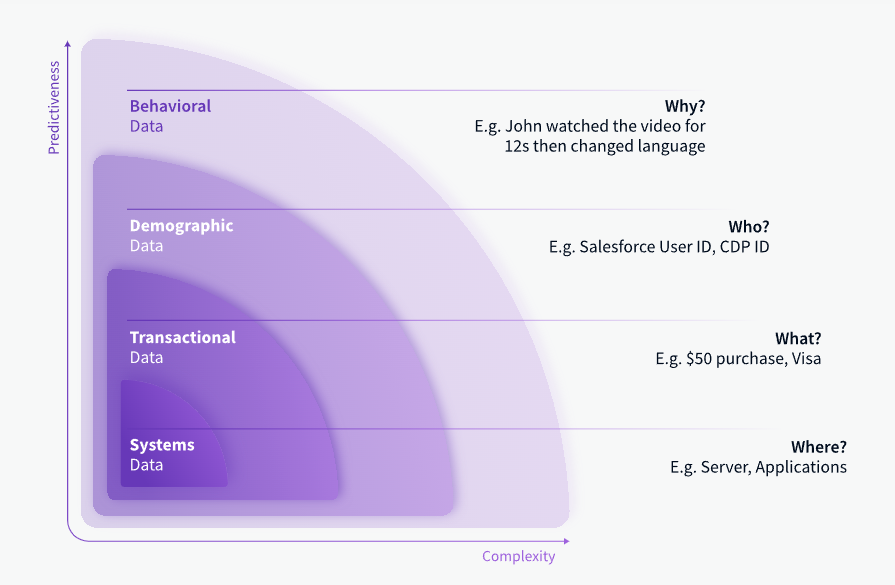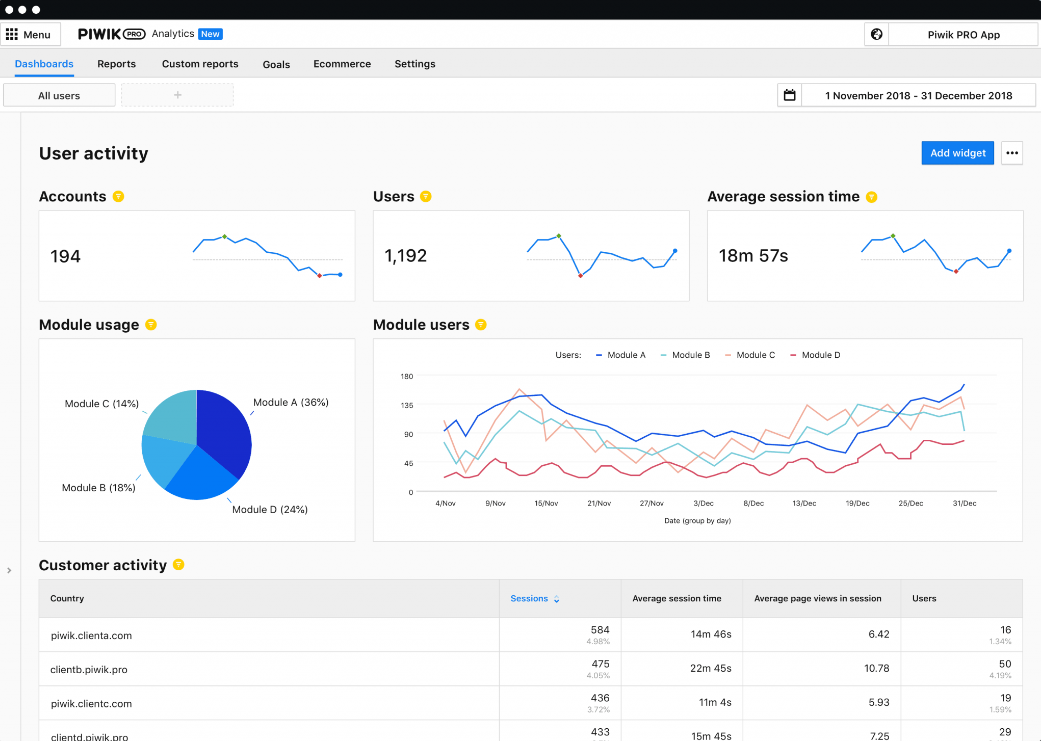Behavioral data refers to information collected about customers’ actions when interacting with your business across channels – their website clicks, mobile app usage, online purchases, email engagement, and even real-world interactions (e.g. in-store foot traffic). Behavioral data collected and owned by your business is primarily first-party data, which is valuable for achieving accurate customer insights.
What differentiates behavioral data from other types of data is that it reveals why users behave the way they do rather than just what they are doing. This powers data-driven decision-making across your organization regarding optimizing product offerings, website experiences, marketing campaigns, and more. Ultimately, behavioral data enables you to grasp what customers expect from your product and deliver more personalized, relevant experiences.

Examples and sources of behavioral data
Behavioral data represents real, observable actions customers take across both digital and physical environments. This information directly signals what customers do and eliminates the guesswork around their intentions.
Behavioral data can be obtained from both online and offline sources.
Examples of online behavioral data
- Website interactions: clicks, searches, page visits and video views.
- Mobile and web app usage data and metrics.
- Ecommerce store interactions: adding an item to a cart, abandoning a cart, creating an account and canceling an order.
- Form submissions.
- File or app downloads.
- Email metrics: open, click-through and unsubscribe rates.
- Customer service interactions across channels.
- Point-of-sale (POS) and transactional data.
- Social media interactions: likes, reactions and comments.
- Product reviews.
Examples of offline behavioral data
- In-store purchases and returns.
- Foot traffic patterns and in-store interactions.
- Call center conversation topics.
- Event participation and engagement.
- Loyalty program activity.
- Service and consultation appointments.
The first-party nature of most behavioral data makes it useful for brands looking to better understand their customers. Because first-party data comes from direct customer interactions, it is highly actionable for optimization and inherently compliant with privacy laws if managed responsibly.
Compared to third-party data, the use of which has been a growing ethical and regulatory concern, transparent first-party behavioral data collection minimizes various errors and misuse risks.
How behavioral data can help you better understand your customers
Businesses gain invaluable insights into customer preferences, needs, pain points, and expectations by analyzing the myriad of their interactions – from browsing patterns on a website to purchase histories. This data allows companies to tailor their products, services, and marketing efforts to better align with customer behavior. Such alignment not only enhances the customer experience but also drives business growth through increased loyalty and sales. In essence, behavioral data acts as a compass guiding businesses toward more customer-centric strategies.
Here are a few areas where behavioral data proves useful:
- Targeted marketing campaigns: Businesses can use customer data insights in other systems, such as CRM or marketing tools, to target customers with personalized content and offers.
- Cross-sell and upsell opportunities: Understanding past purchases and preferences allows for targeted cross-selling and upselling, enhancing customer value.
- Optimizing sales processes: You can boost your customer acquisition and retention efforts, reduce churn, and improve customer LTV.
- Personalized customer experiences: User behavior will tell you what content people read, which pages are most popular, how people navigate between pages, and what they look for using site search. With this data, you’ll know how to structure information for easy navigation.
- Insights for product development: Behavioral data is a trove of information on ways to make your products better.
- Improved customer conversion and retention: Tracking the customer journey enables targeted interventions at different stages, enhancing conversion and retention strategies. This is especially important for product teams trying to better understand users and improve their experience.
- Enhanced customer support: Behavioral data aids customer support teams in identifying friction-heavy touchpoints and providing tailored and effective support where needed.
- Identifying high-value customers to sell more: By analyzing purchasing habits and engagement, ecommerce businesses can segment users to target and nurture the most valuable ones.
- Churn prevention: Behavioral data about product usage can help identify customers at risk of churning, allowing for proactive engagement and retention strategies.
Behavioral data analytics
Companies can use behavioral data analytics to understand what people do on a website, from when they first visit to when they buy a product. This helps businesses identify what makes customers go through with a purchase and what stops them from buying. Equipped with this information, they can make their websites more appealing to what customers want, increasing their satisfaction and loyalty and making them more likely to spend money.
Behavioral analytics is also great for spotting the most valuable customers. This allows companies to apply their marketing resources where they offer the best return. Also, by understanding what customers like, companies can personalize their content to each customer. This helps grab their attention and encourage them to return in the future.
Lastly, behavioral data is useful for maintaining customers. By learning what customers buy and what they like, companies can devise smart ways to keep them interested and stop them from going to other brands. This is crucial for maintaining a steady group of loyal customers to nurture.
The challenges of collecting and using behavioral data
Using first-party behavioral data for customer insights entails specific governance, analytical, and ethical challenges. With the growing variety and volume of data gathered across platforms and environments comes complexity – and without careful management, missteps occur.
Failing to mindfully collect, resolve, store, analyze, and activate behavioral data can undermine analytics accuracy, regulatory compliance, and customer trust. Here is how organizations can address the challenges of collecting and using behavioral data:
| Challenge | Solution |
|---|---|
| Compliance with privacy laws (GDPR, CCPA and others) | Implement a comprehensive data management platform that ensures compliance with privacy laws. This could include features for consent management, data access, and permission control. |
| Respecting consumer advertising preferences | Utilize preference management tools to track and honor consumer choices, aligning with “Do Not Sell” and “Do Not Track” lists. |
| Data retention schedules | Deploy automated data lifecycle management systems that enforce retention policies and schedules, ensuring timely deletion of data. |
| Right-to-access policies | Implement user-friendly data access portals that allow consumers to view, transfer, and delete their personal data easily. |
| Integrating data from various sources | Use advanced customer data platforms (CDPs) for centralizing and reconciling data from disparate sources into accurate customer profiles. |
| Maintaining scalable data infrastructure | Develop or adopt scalable cloud-based infrastructure solutions with robust data processing capabilities, such as Apache Kafka for streaming data. |
| Filling in specialized data roles | Focus on talent acquisition and training programs to fill specialized roles like data or AI ethicists and Data Protection Officers. |
| Cross-departmental collaboration | Implement collaboration platforms and inter-departmental workflows. For example, use tools like Slack for communication and Trello for project management. |
| Dealing with reputational risks connected with unlawful data practices | Adopt a transparent approach to data usage, with clear consumer communication strategies and open disclosure policies. |
| Cybersecurity | Strengthen cybersecurity measures by using advanced security solutions, such as firewalls, intrusion detection systems, and regular security audits. |
Best practices for working with behavioral data
You can leverage behavioral data responsibly and effectively if you:
- Collect explicit consent and be transparent. Communicate how the collected data will be used and obtain opt-in consent from customers when required.
- Prioritize privacy and security. Follow regulations like GDPR to honor user privacy rights. Implement relevant measures, such as data anonymization and appropriate security measures.
- Maintain data integrity. Carefully process and structure behavioral data to correct errors. Record metadata like timestamps and sources.
- Develop strong data governance. Document policies for behavioral data collection, storage procedures, access controls, and oversight procedures aligned with regulations.
- Prioritize data minimization. Treat data as a liability, not an asset. Continuously evaluate ways to collect less data while preserving analytical value.
- Use homegrown identity resolution. Avoid buying third-party data for identity resolution. Develop compliant strategies like zero-party data collection.
- Build an ethical data culture. Foster awareness and shared responsibility for using data ethically across teams via training and leadership.
These best practices form the foundation for maintaining customer trust by putting their well-being first. While an investment initially, this pays long term dividends across both ethical and performance metrics.
Behavioral analytics
Collecting and interpreting behavioral data constitutes the basis for all analytical endeavors. The effectiveness of behavioral analytics depends on the quality and comprehensiveness of the behavioral data collected.
Organizations collecting relevant, high-quality behavioral data can extract more meaningful insights through analytics. This leads to more informed decision-making across fields like marketing and product development.
Behavioral analytics for marketing teams
Behavioral analytics in marketing involves analyzing customer data to understand purchasing patterns, content preferences, and activity on different marketing channels. This approach enables marketers to create targeted campaigns, personalized content, and strategic product placements that resonate with the audience. For instance, by analyzing website visit patterns, a marketer can tailor email campaigns to specific user interests, increasing engagement and conversion rates.
Behavioral analytics for product teams
In product management, behavioral analytics focuses on how users interact with a product. This data helps product teams make informed decisions about design, features, and user experience. For example, by tracking how users navigate an app or website, product teams can identify pain points, optimize user flow, and enhance overall usability. This directly contributes to improved customer satisfaction and retention.

Tools and platforms that handle behavioral data
Managing behavioral data effectively requires specialized tools and platforms that can handle large volumes of data, integrate various data sources, and provide actionable insights. Here are some of the key types of tools and platforms for managing behavioral data:
| Tool | Function | Examples |
|---|---|---|
| Customer data platforms (CDPs) | Centralizing customer data from multiple sources into a unified database for a 360-degree customer view, segmentation and data activation. | Segment, Tealium, Adobe Real-time CDP, Piwik PRO CDP |
| Data management platforms (DMPs) | Managing data from third-party sources for advertising, aiding in audience segmentation and targeting. | Oracle BlueKai, Lotame |
| Web analytics tools | Tracking and reporting web traffic and user behavior, providing insights into user navigation and conversions. | Google Analytics, Adobe Analytics, Piwik PRO Analytics Suite |
| Behavioral analytics software | Analyzing complex user behaviors and patterns, identifying trends and predicting user actions. | Mixpanel, Amplitude, Piwik PRO Analytics Suite |
| Marketing automation platforms | Marketing automation based on behavioral triggers across various channels. | HubSpot, Marketo |
| CRM systems | Managing customer data for sales and marketing, tracking interactions throughout the customer lifecycle. | Salesforce, Zoho CRM |
| Business Intelligence (BI) tools | Data analysis, reporting, and visualization for strategic decision-making. | Tableau, Microsoft Power BI |
| Consent management platforms | Managing user consent and ensuring compliance with data privacy regulations. | OneTrust, Quantcast, Piwik PRO Consent Manager |
Choosing a customer data platform (CDP)
A CDP is a key element in any data stack handling behavioral data. It helps businesses align with their strategic goals, compliance requirements, and operational needs. Organizations should consider several criteria when selecting a CDP to ensure the platform meets their specific needs.
Data integration and import
Look for a CDP that can easily connect siloed data sources into clear records, mapping all user traits and behaviors. This includes integration with CRM, ecommerce platforms, and data warehouses without coding.
Behavioral segmentation and audience building
Choose a CDP that allows you to trigger audiences based on various conditions, including real-time customer interactions. The platform should offer flexibility in defining audiences, allowing segmentation based on demographic and behavioral data.
Data activation and personalization
Ensure the CDP can personalize customer experiences across channels and activate data to reach the right people at the right time. This involves customizing user profiles with attributes specific to your business and customers.
Privacy and compliance
The CDP should prioritize user privacy and help you comply with global privacy laws like GDPR, TTDSG/TDDDG, CPPA, CPRA, LGDP, etc. This includes safe hosting options, data governance, and built-in integration with consent management tools.
Integrated analytics and tag manager
A CDP that natively offers analytics and tag management provides a steady stream of valuable user data for more comprehensive insights.
Flexibility and customization
The platform should offer custom connectors and an intuitive editor for activations, catering to unique business needs without involving technical teams.
Support
Leading CDP vendors offer comprehensive professional services and customer support, including implementation, onboarding, product training, analytics consulting, and custom integrations.
Creating behavioral audiences in Piwik PRO CDP
Piwik PRO CDP lets you divide your customer base into smaller groups based on user attributes or behavioral data.
Behavioral audiences are based on the idea that customers who exhibit similar behaviors are more likely to have similar needs and preferences. By focusing marketing efforts on these groups, businesses can increase their effectiveness.
Behavioral audiences can be centered around various interactions with your organization’s website or app. Below are a few examples of behavioral audiences you can create in Piwik PRO CDP and goals you can achieve by targeting them with relevant activations:
| Goal | Audience |
|---|---|
| Increase conversion from free to paid users | Customers who visited the Pricing page three times in the last seven days and are on a free plan. |
| Personalize customer experience for visitors that came from a given campaign | Visitors whose first touchpoint with the brand was the Spring campaign. |
| Increase form completion rate | Users who visited a page with loan-form in the URL in the last two hours, didn’t visit a page with request-thank-you in the URL in the last two hours, and have been inactive for 30 minutes. |
| Increase sales through cross-selling | Users who visited pages with laptop and charger in the URL and didn’t visit pages with headphones in the URL and made no purchase. |
| Re-engage inactive big spenders | Customers who spent at least $5,000 in the store but haven’t performed any actions in 14 days. |
| Encourage people to collect packages from the parcel locker sooner | Customers whose package was placed in a parcel locker in the last 24h and taken out out of the locker in the last 24h. |
Learn about other ways you can benefit from using a CDP: 8 customer data platform (CDP) use cases that will drive your business growth.
Conclusion
Behavioral data shows how well you connect with your customers. When you group them correctly and reach them with the right content, they’ll feel like you’re talking just to them. And, like transactional data, you can make behavioral information work for you using a customer data platform, such as the one offered by Piwik PRO.
If you want to learn more about how Piwik PRO CDP can help you make the most of your users’ behavioral data, reach out to us:










